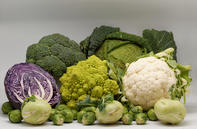The air temperature of an agricultural area is very important to agriculture for its effects on the growth and production of different crops. The physiological, chemical and biological processes in plants, such as photosynthesis, are influenced by air temperature.

Photosynthesis is the process in which agricultural crops use sunlight to produce carbohydrates, dry matter or yield, out of water and carbon dioxide. Most plants grow and live within a temperature range of 0°C to 50°C but for any crop, the optimum temperature range for optimum growth and production is narrow.
Cool Weather and Warm Weather Crops
Cool weather crops include cabbages, carrots, beetroot, lettuce, spinach, peas and onions. These crops grow best at temperatures ranging from 15ºC to 18ºC. Warm weather crops such as beans, pumpkins, squashes, cucumbers, potatoes, maize and tomatoes grow best at temperatures ranging from 18ºC to 27ºC.
The so-called “cardinal” temperature ranges (lower tolerable, optimal, higher tolerable) is different between crops but also between different growth stages of the same crop. In the case of cool weather crops, it is important to determine best planting dates that will ensure that the crop is grown under optimal temperature conditions.
Temperature and Crop Diseases
Air temperature, combined with relative humidity, water vapour or moisture in the air, often determine crop diseases but can also be beneficial in some cases. A good example is greening disease, a virus disease, in citrus. It is a serious problem in Mpumalanga and Limpopo Provinces, but not in the Western and Eastern Cape Provinces.
The insect carrying and distributing the virus cannot survive high temperatures and it appears that the scorching hot, dry berg winds of the Western and Eastern Cape citrus growing areas are probably the reason for the absence of greening disease in these areas.
Rain and Temperature
Local temperature and rainy seasons play a role in the final choice of crops. For example, as grapes are susceptible to fungal diseases when planted in a humid climate, grapes should be grown in an area where rainfall is low or in a winter rainfall area.
Subtropical crops, e.g. avocado, guava, litchi, mango, passion fruit, pawpaw and pineapple, can only be grown successfully in areas with no frost. Dates need about 180 days with daily temperatures higher warmer 18ºC and very low rainfall for successful fruit production.
Temperature and Crop Quality
Sometimes small temperature differences can affect the quality of the product. The sugar content of sugar beet reduces if temperatures during the growing season are too low. Similarly when the length of the growing season is not long enough not enough sugar is produced.
The length of the growing season and high enough temperatures are also important for warm weather summer crops. Maize requires long seasons but high yielding shorter season cultivars have now been developed.